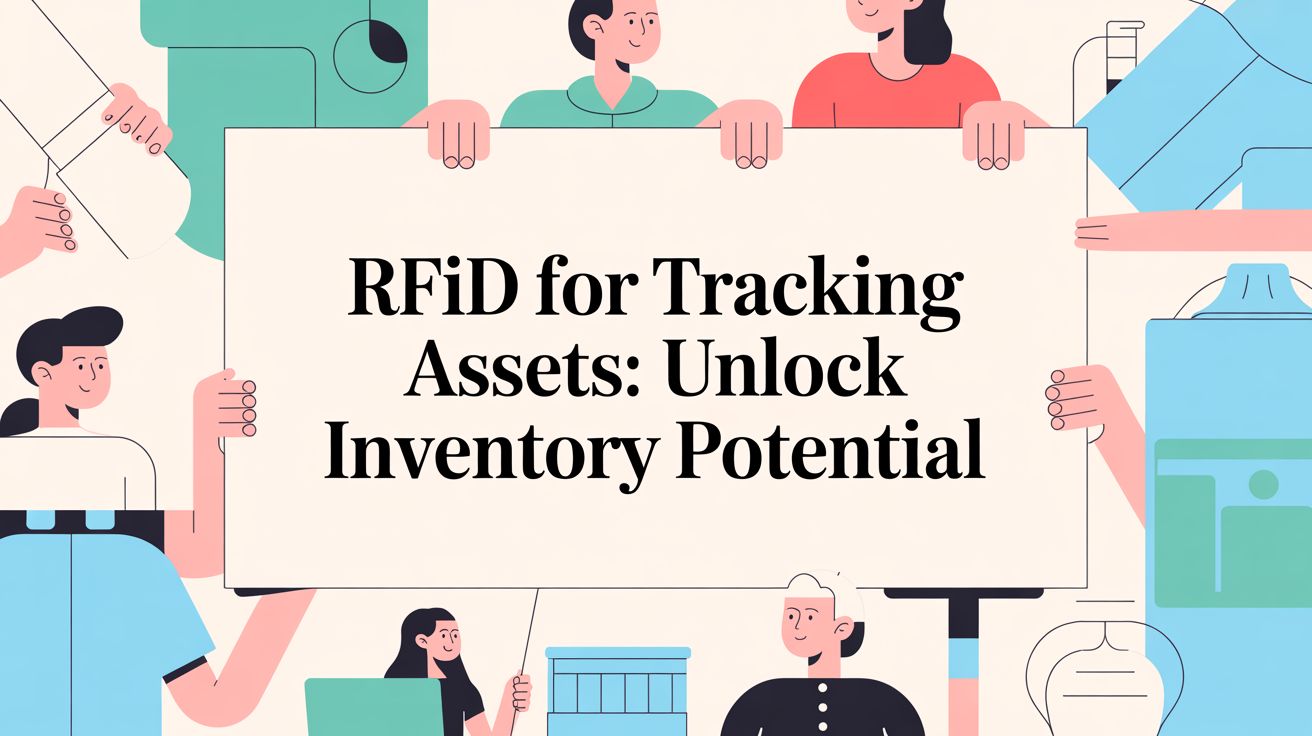A good closet organization system is so much more than just a few extra shelves. Think of it as a custom-built framework designed to squeeze the maximum potential out of every inch of your space, cut down on the clutter, and genuinely make your daily routine easier. When you tailor storage to your actual wardrobe, you can transform a chaotic closet into a functional (and peaceful) part of your home.
Matching a System to Your Lifestyle
Let's be honest, getting your closet organized can feel like a monumental task, and just figuring out where to start is half the battle. A well-designed system is the secret weapon. It’s not just about tidying up; it's about creating a personalized solution that works for you, not against you.
Whether you're trying to tame a massive shoe collection, find a home for long dresses that are always crumpled at the bottom, or create a shared closet that doesn't lead to arguments, the goal is the same: align the system with your real-life habits and possessions. When you get this right, staying organized starts to feel effortless.
First, Understand Your Primary Needs
Before you fall in love with a specific brand or a fancy wood finish, you need to do a quick personal inventory. The single biggest mistake people make is choosing a system based purely on looks, only to discover it’s completely impractical for their actual stuff. A person with fifty pairs of shoes needs a totally different layout than someone with a closet full of bulky winter coats.
The best closet systems are the ones that solve your biggest headaches. If your shoes always end up in a pile on the floor, then shoe storage should be your top priority. If you can never find the right belt, a dedicated accessory organizer is non-negotiable.
Taking a moment for this self-assessment saves you from investing in a setup that's beautiful but ultimately useless. It ensures the final design is built around your life. For a deep dive into this process, our guide on creating a decluttering closet inventory is a great place to start.
This infographic is a handy way to visualize that initial decision-making process, especially when it comes to budget and your comfort level with installation.

As you can see, the path forward really hinges on those key choices: budget-friendly vs. custom, and DIY vs. professional installation.
Explore the Core Types of Closet Systems
Once you've pinpointed your main challenges, you can start exploring the different kinds of systems out there. Each one comes with its own pros, cons, costs, and installation quirks, so there’s something for every skill level and budget.
And you're not alone in wanting a better system. The global market for closet organizers is expected to jump from USD 4.03 billion in 2025 to nearly USD 8.53 billion by 2035. This isn't just a niche trend; it shows a massive shift toward investing in more functional, organized living spaces.
To make it easier, here’s a quick breakdown of your main options.
Closet System Types at a Glance
This table gives you a quick comparison of the most common closet organization systems. Use it to get a feel for the best starting point based on your needs, budget, and how much work you're willing to put in.
| System Type | Best For | Average Cost | Installation Difficulty |
|---|---|---|---|
| Wire | Budget-conscious DIYers, renters, and closets needing good ventilation. | $100 – $500 | Easy |
| Laminate/Wood | Homeowners wanting a durable, built-in look with lots of finish options. | $500 – $2,500 | Moderate |
| Modular | Those who want a semi-custom feel without the full custom price tag. | $300 – $1,500+ | Easy to Moderate |
| Custom Built-In | Anyone needing to maximize a unique space or wanting a premium, tailored solution. | $2,000 – $10,000+ | Professional Installation |
Let's dig a little deeper into what each of these really means for your closet.
- Wire Closet Systems: These are the go-to for affordability and simple installation. Their open design is fantastic for airflow (no more musty clothes), and because they're modular, you can easily tweak the layout down the road.
- Laminate and Wood Systems: If you're after a more permanent, polished look, this is it. These systems are incredibly durable and come in tons of different finishes to match your home’s style. They often feature a mix of shelving, drawers, and cabinets for that high-end, built-in feel.
- Modular Closet Systems: Think of these as the happy medium between a basic kit and a full custom job. You get to play designer, mixing and matching components like towers, shelves, and drawers to build a layout that fits your specific space and needs.
- Custom Built-In Closets: For the ultimate in organization, nothing beats a custom solution. A professional will design and install a system tailored to the exact dimensions of your closet and your entire wardrobe, making sure not a single inch goes to waste.
By the time you're done exploring these options, you'll have a much clearer vision of what a perfectly organized closet looks like for you. It makes the whole project feel less daunting and a lot more personal.
Planning and Measuring Your Closet Space

A successful closet overhaul starts with a tape measure and a plan, not an impulsive trip to the store. Trust me, I’ve seen the results of jumping straight to buying components. It almost always ends in frustration, wasted money, and a system that just doesn't quite fit. A detailed blueprint is the absolute foundation for effective closet organization systems, ensuring every piece you choose has a purpose and a place.
Think of this phase as creating a roadmap for your project. By taking the time to carefully map out the terrain of your closet, you can spot potential problems, make smarter decisions, and see the final result in your mind's eye before you even touch a drill. That initial investment of time pays off big time when installation day arrives.
Taking an Inventory of Your Wardrobe
Before you measure a single wall, you need to understand what's actually going in the closet. The whole point is to design a system that fits your specific wardrobe, not some generic template. Start by pulling everything out and sorting it into categories: shirts, pants, dresses, shoes, accessories, you get the idea.
This isn't just about decluttering; it's about collecting crucial data. You need to ask yourself some real questions to figure out your storage needs.
- Hanging Space: How much rod space do your short-hanging items (shirts, jackets) take up? What about long-hanging things like dresses or coats? Get out the tape measure and find out the linear feet.
- Folded Items: Actually count your sweaters, jeans, and t-shirts. This number will tell you exactly how much shelving or drawer space you need.
- Shoes and Accessories: Do you have tall boots that need specific vertical clearance? A pile of belts or scarves that could use a specialized rack? Make a note of it.
Jotting down these quantities will directly shape your design. If you discover you own mostly folded clothes and only a handful of hanging pieces, a system loaded with shelves will serve you far better than one with endless hanging rods. Taking a detailed inventory is also the first step toward creating more advanced organizational methods later on. You can even explore how this data can be integrated into visible built-in closet systems that make finding anything effortless.
How to Measure Your Closet Accurately
With your wardrobe audit complete, it’s time to measure the physical space. Accuracy is everything here, so grab a quality tape measure, a notepad, and a pencil. Don't round your numbers; that quarter-inch you ignore now will come back to haunt you later.
First, sketch a quick diagram of your closet, including the floor, ceiling, and all four walls. It doesn’t need to be a masterpiece, just a clear layout. Then, start recording these measurements on your sketch.
- Interior Width: Measure the width from wall to wall at three different heights, top, middle, and bottom. Walls are rarely perfectly plumb, so always use the smallest of the three measurements for your plan.
- Interior Depth: Measure from the back wall to the front opening. Again, do this at a few points and use the narrowest measurement to be safe.
- Ceiling Height: Measure from the floor to the ceiling in at least two different spots. If you have a sloped ceiling, make sure to measure both the shortest and tallest heights.
One of the most common pitfalls is forgetting to account for obstructions. These are the little real-world details that can completely derail an installation if you ignore them.
Be sure to locate and measure anything that protrudes into the space. I'm talking about light fixtures, electrical outlets, light switches, attic access panels, and air vents. Also, measure the width and height of the baseboards and any door trim, as these will affect how a floor-based system sits against the wall. Finally, grab a stud finder and mark the location of the wall studs; this is non-negotiable for securely anchoring your new system.
Sketching Your Closet Layout
Now for the fun part. You get to combine your wardrobe inventory with your closet measurements to create a layout. You can do this the old-fashioned way with graph paper (let each square represent a few inches) or use one of the many free online design tools offered by closet system manufacturers.
Start by placing your highest-priority storage zones. For instance, if you figured out you need 8 feet of short-hanging space, draw that in first. Then, add the shelving and drawer space you calculated. Don't be afraid to play with different configurations.
Common Layout Strategies:
- Reach-In Closets: The key here is maximizing vertical space. Put a shelf above the top hanging rod for out-of-season items. A double-hang rod setup (one rod above the other) is a game-changer that instantly doubles your capacity for shirts and pants.
- Walk-In Closets: An L-shaped or U-shaped design makes the most of the floor plan. Don't let the corners go to waste, as corner shelves or curved rods can turn those awkward areas into incredibly useful storage.
- Sloped Ceilings: This is where custom solutions really shine. Use the tallest wall for your long-hanging clothes and fit stepped shelving or shorter hanging rods right under the slope.
By drafting a detailed plan, you create a clear blueprint that eliminates all the guesswork. This plan will guide your purchases, make the installation process a breeze, and ensure your new closet organization system is a perfect match for both your space and your life.
Choosing the Right Closet System for Your Budget
Okay, you’ve got your closet blueprint in hand. Now comes the fun part: picking the actual system. This is where you balance your budget, your style, and just how much of a DIY warrior you feel like being. It's all about finding that sweet spot where cost meets quality and functionality.
The market for these systems is huge, so it helps to break it down into the most common types. Each one comes with its own set of trade-offs. Think about your long-term goals here. Are you looking for a quick, cheap fix for a rental, or are you investing in a serious upgrade for your forever home? Your answer will point you in the right direction.
Wire Systems: The Budget-Friendly Workhorse
Wire closet systems are usually the first stop for anyone needing an affordable, no-fuss solution. They’re made from steel coated in vinyl or epoxy, making them lightweight, surprisingly strong, and pretty easy to install. Their biggest selling point is the price, you can often outfit a standard closet for a fraction of what other systems cost.
Another big plus is airflow. The open design of wire shelving keeps clothes from getting musty, which is great for storing seasonal stuff or if you live in a humid climate. But they’re not perfect. The wire grid can leave imprints on delicate fabrics like sweaters, and smaller items have a bad habit of falling through the gaps. Aesthetically, they give off a more utilitarian vibe that might not be for everyone.
For renters or anyone on a tight budget, wire systems offer unbeatable value. They deliver a massive functional upgrade without a huge financial hit, making them a smart and practical choice for getting organized right now.
Wire systems are perfect for:
- Garages and utility closets where function is way more important than form.
- Kids' closets that you know you'll need to reconfigure as they grow.
- Anyone new to DIY projects looking for a simple, forgiving installation.
Laminate Systems: The Built-In Look for Less
If you’re craving the substantial look of custom cabinetry but don’t have the budget for it, laminate systems are an excellent middle ground. These kits are typically made from particleboard covered in a durable laminate finish, and they give you a polished, built-in look that instantly makes a closet feel more upscale.
They come in all sorts of finishes, from classic white to rich wood grains, so you can match your home’s decor. The solid shelving gets rid of the issues you see with wire systems, giving you a smooth, stable surface for folded clothes. While they cost more than wire, they're still way more affordable than a fully custom job.
The main drawback? Installation. These systems are heavy and demand more precision, turning it into a more involved DIY project. You’ll need to be comfortable with cutting shelves to the right size and securely mounting heavy components to the wall.
Modular Systems: The Flexible and Modern Choice
Modular closet systems are one of the fastest-growing options in home storage, and it’s easy to see why. These systems are made up of individual components, such as shelf towers, drawer units, and hanging rods, that you can mix and match to create a semi-custom layout. That flexibility means you can design a solution that perfectly fits your space and exactly what you need to store.
The demand for customizable, premium storage has fueled this trend. The U.S. home organizers market, valued at USD 12.05 billion in 2025, is projected to hit USD 15.21 billion by 2030, with modular units leading the way. This shift shows that people want adaptable systems that can evolve with them. You can check out more data on this growing home storage market.
This approach also lets you start small and add on over time. For instance, you could begin with a basic tower and a couple of rods, then add drawers or shoe shelves later when your budget allows.
Professional Custom Closets: The Ultimate Tailored Solution
For those who want to maximize every single inch of a weirdly shaped space or just want a truly premium finish, nothing beats a professional custom closet. This is the top-tier option. A designer works with you to create a one-of-a-kind system built precisely around your wardrobe and your life.
The process usually breaks down like this:
- Initial Consultation: A designer comes to your home, measures the space, and talks through your needs, your inventory, and what you want it to look like.
- Design Presentation: You get a 3D rendering of the proposed design. This is your chance to see exactly how it will look and make any tweaks.
- Material Selection: You get to choose from a huge range of high-end materials, finishes, hardware, and cool accessories like valet rods, jewelry inserts, and built-in lighting.
- Professional Installation: A specialized crew handles the entire installation from start to finish, ensuring a perfect, secure fit.
It's definitely the most expensive route, but the result is a perfectly optimized, beautifully integrated storage space that can seriously increase your home's value. It takes all the guesswork and DIY labor off your plate and delivers a flawless closet built to last a lifetime.
Installing and Customizing Your New Closet

Alright, this is the moment of truth. All that planning, measuring, and dreaming is about to pay off as you turn a pile of boxes into a functional, beautiful reality. For the dedicated DIYer, a bit of prep and the right tools are all that stand between you and a perfectly organized space.
Taking a little time to prep the closet before a single shelf goes up makes a world of difference. A fresh start ensures your new closet organization system not only looks incredible but is also installed securely. This foundational work prevents those common DIY frustrations and sets the stage for a finish that looks professionally done.
Getting Ready for Installation
Before you even think about unboxing those components, give your closet a proper once-over. Empty it completely, then give the walls and floor a good cleaning. This is the perfect time to patch any old nail holes or dings in the drywall and roll on a fresh coat of paint. A clean, bright interior will make your new system pop.
Next, get your tools in order. Having everything you need within arm’s reach will save you a dozen frustrating trips back and forth to the garage and keep your momentum going.
Essential DIY Installation Toolkit:
- Tape Measure: For double-checking everything as you build.
- Level: Absolutely critical. Nothing screams "amateur job" like a crooked shelf.
- Stud Finder: Don't skip this. Locating wall studs for secure anchoring is a non-negotiable safety step.
- Drill with Assorted Bits: For pre-drilling holes and driving screws home.
- Pencil: For marking your measurements and stud locations right on the wall.
With a prepped space and your tools ready, you can finally, and confidently, start the assembly.
Navigating Common Installation Hurdles
Even the best-laid plans can hit a snag. The real world of home renovation is rarely perfect. Older homes, in particular, are notorious for having walls that aren't perfectly plumb or corners that aren't a true 90 degrees. Don't sweat it; these are common issues with pretty straightforward fixes.
If you find an uneven wall, you may need to use shims (small wedges of wood or plastic) behind your mounting brackets to create a level surface. When it comes to finding studs, a reliable electronic stud finder is your best friend. Always anchor heavy components, like shelving towers and hanging rods, directly into studs. This ensures they can actually support the weight of your entire wardrobe without pulling away from the wall.
A secure installation is a safe installation. Taking a few extra minutes to find studs and use the correct hardware isn't just about looks; it's about building a durable system that will last for years without sagging or failing.
The demand for these kinds of solutions is booming, which shows just how much people want efficient, personalized storage. The global home built-in closet market was valued at USD 38.78 billion in 2025 and is expected to keep growing. This trend highlights the value we all place on creating organized living spaces. You can dive deeper by exploring research on the home built-in closet market.
Adding the Finishing Touches That Matter
A truly great closet is more than just shelves and rods. It's the thoughtful little details that elevate its function and make your daily routine feel effortless. Once the main structure is installed, start thinking about accessories that cater to your specific wardrobe. These are the finishing touches that transform a standard system into a personalized sanctuary.
Think about the small annoyances in your current setup. Is your tie collection a tangled mess? Is your jewelry in a constant state of chaos? These are the exact problems you can solve now with smart customization.
- Valet Rods: A simple pull-out rod is a game-changer for planning the next day's outfit or hanging dry cleaning.
- Pull-Out Racks: Get specialized racks for ties, belts, and scarves to keep them neat, visible, and easy to grab.
- Drawer Inserts: Divided inserts for jewelry, socks, or underwear bring instant order to your drawers and protect delicate items from getting jumbled.
- Integrated LED Lighting: Adding motion-activated or switch-operated lighting can be a revelation, especially in deep or dark closets where things tend to disappear.
These final additions are what complete the vision for your closet. They turn a simple storage area into a highly functional part of your home, making getting dressed every single day a little more joyful.
Maintaining Long-Term Closet Organization
Installing your new system is a huge accomplishment, but the real victory lap comes months later when everything is still in its place. Let's be honest, the true goal of any great closet organization system is making it last. It’s about creating an environment where staying organized feels easier than letting things descend back into chaos.
This isn’t about a one-time purge that gives you a temporary high. It's about building a living system that adapts with you, making it almost effortless to keep your space orderly and stress-free year after year.
The One-In, One-Out Rule
If you adopt only one habit from this guide, make it this one. The "one-in, one-out" rule is the single most powerful principle for preventing new clutter from taking over. It’s a beautifully simple concept that acts as a gatekeeper for your closet.
Every time you bring a new item home, an old one has to go. Bought a new pair of jeans? An old pair gets donated or sold. This isn't about deprivation; it's about mindful consumption and keeping things in balance. It forces you to stop and ask if you really need that new thing, preventing your carefully organized space from slowly becoming overstuffed again.
Think of your closet as having a fixed capacity. The one-in, one-out rule respects that limit, ensuring you never exceed what your system was designed to handle. It turns a finite space into a perpetually manageable one.
Mastering the Seasonal Wardrobe Swap
For most of us, a huge chunk of our wardrobe is seasonal. Storing bulky winter sweaters next to summer dresses isn't just inefficient; it creates visual noise and makes finding what you need a daily struggle. A well-executed seasonal swap is your secret weapon for keeping your most-used items front and center.
Instead of a chaotic weekend project, approach it systematically. Twice a year, set aside a few hours to rotate your clothes. As you pack away off-season items, take the opportunity to give each piece a quick once-over. Did you wear that coat at all last winter? Is that swimsuit still in good shape? This process gives you a natural, recurring decluttering session.
Use clearly labeled containers for off-season storage.
- Vacuum-sealed bags are a game-changer for bulky items like puffers and sweaters, drastically reducing the space they occupy.
- Clear plastic bins let you see the contents at a glance, making it easy to find a specific sweater if the weather turns unexpectedly.
- Under-bed containers are perfect for stashing shoes and accessories that you won’t need for several months.
The Power of Labels and Containers
An organized closet is one where every single item has a designated home. This is where simple labeling and smart containerizing become your best friends. When every category of item has a clearly marked bin or shelf, cleanup becomes a thoughtless, quick process. No more guesswork.
Think of it as creating a visual map of your closet. Use a label maker or simple stick-on tags to identify the contents of every box, basket, and drawer. Be specific: "Winter Hats" is way more helpful than "Accessories."
For smaller items, containers are non-negotiable. Baskets are great for corralling scarves and belts, while drawer dividers can finally tame a chaotic sock collection. This approach also works wonders beyond the closet; many stylish storage solutions for your home can help you declutter every room. Consistent labeling turns maintenance from a chore into a simple matching game.
By putting these strategies into play, your closet system transforms from a static installation into a dynamic part of your daily routine. It becomes a tool that not only stores your belongings but actively helps you stay organized for the long haul.
Answering Your Biggest Closet System Questions
Even with a perfect plan in hand, diving into a closet makeover can bring up a lot of questions. From the nitty-gritty of budgeting to the big picture of design philosophy, getting the right answers now can save you a world of frustration later. Let's tackle some of the most common things people wonder about when upgrading their closet.
Think of this as the final check before you start swinging a hammer. A little bit of insider knowledge goes a long way in making sure your investment of time and money pays off.
How Much Should I Budget for a Closet Organization System?
This is the big one, and the honest answer is: it varies wildly. Your final cost is a mix of three things: the closet's size, the materials you pick, and whether you're a DIY warrior or calling in a pro.
Let's break it down into real-world numbers:
- The Budget-Friendly DIY Route: A basic wire system for a standard reach-in closet is your most affordable option. You can usually get this done for $100 to $300. It's simple, effective, and gets the job done.
- The Upgraded DIY Kit: If you want something that looks more built-in, a laminate or melamine kit from a big-box store is a great middle ground. Plan for anywhere from $400 to $1,500, depending on the size and complexity.
- The Modular Walk-In: For larger walk-in closets, modular systems offer a fantastic blend of customization and value. These typically fall in the $800 to $2,500 range.
- The Full Custom Experience: This is the premium end of the scale. A fully custom-designed and professionally installed closet often starts around $2,000 and can easily soar past $10,000 for sprawling spaces with all the bells and whistles, like built-in lighting and custom drawer inserts.
Don't forget the hidden costs! Always pad your budget a little for things like paint to prep the walls, a new tool you didn't realize you needed, or the perfect set of bins to complete the look.
Can I Install a Closet Organization System Myself?
Absolutely. In fact, most of the wire and modular kits you'll find at home improvement stores are designed specifically for you, the weekend DIYer. If you're comfortable with a drill, a level, and a stud finder, you have all the skills you need to get a professional-looking result.
The secret to a successful DIY install isn't raw talent; it's meticulous prep work. Measure twice (or three times!), read the instructions all the way through before you start, and take your time. Rushing is where mistakes happen.
But it's also important to be honest with yourself. If the idea of finding studs in the wall or trying to level a heavy tower unit on your own gives you anxiety, hiring a professional is money well spent. A pro guarantees the system is secure and perfectly fitted, saving you a ton of time and eliminating the risk of a costly (and messy) mistake.
What Is the Most Important Element in a Closet Design?
This might surprise you, but it’s not the beautiful wood finish or the fancy pull-out tie rack. The single most crucial element of a great closet design is functionality that’s built around your actual wardrobe.
It's so easy to get wowed by a pristine showroom closet, but if that design doesn't match the clothes you own, it will fail. Every single time.
Before you commit to a layout, do a quick, honest inventory. Are you a dress person with a need for tons of long-hang space? Or is your life all about folded sweaters and jeans that would be much happier on deep shelves or in drawers?
The most common mistake I see is people installing a generic, "one-size-fits-all" system. For example, double-hang rods are a fantastic space-saver, but they're completely useless if most of your clothes are long coats and dresses. A system that perfectly mirrors the ratio of your clothing types will always outperform one that just looks good in a catalog. Functionality first. That's the golden rule.
Ready to take your organization to the next level? Vorby helps you catalog every item in your new closet, so you can find anything in seconds with a simple search.
Start your free trial and create your digital home inventory with Vorby



